Project Information
- Ore Deposit: Epithermal
- Research Themes: Exploration Methods
- Location: Salta, Agrentina
- Project Status: Completed
- Students: Taylor Ledoux
- Start Date: 2018
- End Date: 2019
The Taron Project is a Miocene epithermal cesium deposit. It is situated in a graben-like structure composed of late Tertiary sedimentary and volcanic rocks (graben fill) straddling the contact between the Eastern Cordilleran Ranges and the Altiplano-Puna volcanic complex in the eastern central Andes. This project is part of the MDRU Exploration Geochemistry Initiative and is supported by Cascadero Copper Corporation.
The deposit is dominated by cryptocrystalline silica, manganates, arsenates, and oxides. Previous assay results identified 2 meter intervals of drill core with up to 0.74 wt.{4f68512a01b6c7d7b16fb2c0178fca0ea196e8717437457c5f4289110417847b} thallium.

At the 2m interval scale, Tl has a positive correlation with Mn, Ba, Cu, and Mo; and bi-modal relationships with Cs, As, Rb, and Ag. fp-XRF spot analysis indicates Tl has a positive relationship with Mn, K, Ba, Hg, and Cu. Reflecting smaller scale mineralogy relationships, Tl is negatively correlated with As, Cs, Rb, and Ca. XRD identified the hollandite supergroup as the primary thallium bearing mineral, indicating Tl is in the +1 oxidation state. Tl and Cs are not hosted within the same mineral: Tl is hosted within the hollandite supergroup; and Cs is hosted within pharmacosiderite. However, the two minerals are spatially associated with each other, as both inclusions and cross-cutting veins at the micron to cm scale.
These findings have significant mineral processing implications for the recovery of Cs from pharmacosiderite without contamination by highly toxic Tl. Zonation of Tl-rich zones and separate Cs-rich zones could have implications for mine planning and ore processing. Residence of Tl within manganates could potentially accommodate tailings disposal of Tl in a non bio-available form.



